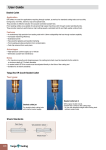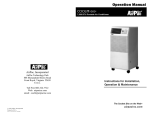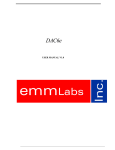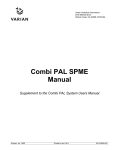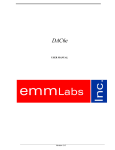Download here - Daat Research Corp
Transcript
APRIL 5, 2001 www.machinedesign.com A PENTON PUBLICATION User review Edited by Paul Dvorak Thermal analysis leads to cool designs Coolit CFD software predicts airflow and heat transfer in electronic equipment. It works this way: An engineer defines a model space and items in it such as enclosures, fans, vents, and systems components. These may be imported from a CAD system or assembled using building blocks from a component library. Point-and-click operations dramatically shorten design tasks. Material properties and component specifications are selected from an online material library, or typed in. After building the model, the software creates an appropriate grid and calculates results. These are displayed using a viewer called CoolPlot that comes with the software. Plots can show a long list of variables including temperatures, velocity, heat flux, pressure, and turbulence intensity that are useful in analyzing problems. Color coding highlights gradations in variable values and pinpoints hot spots. Different variables, such as temperature and pressure, can be overlaid to visualize their interactions. Animation in Coolit puts streamlines in motion, showing nontechnical users how one design, such as the finned heat exchanger, might work better than another. The unusual heat sink was modeled in Coolit. Arrows indicate streamlines. Red is for hotter areas and blue, cooler areas. The software’s parametric features can run through a range of design considerations that more clearly point to a best one. Users can examine results in 3D several ways. For instance, cross sections can show results or users can rotate models and zoom in on areas of concern. When necessary, animation puts streamlines in motion. While working with NEC, we tapped the software to accelerate heat-sink development for a new series of network servers. These are powered by processors ranging from 600 MHz to gigahertz chips. The heat sinks must cool the processors should one of the three redundant system fans fail. We faced an extremely tight introduction schedule and could not afford to spend development time climbing a lengthy learning curve. Consequently, ease of use was a prime consideration for selecting the CFD package. We downloaded the software from the vendor, installed it, and had it running in 30 min. The User Manual and online Help are succinct and to the point. One particularly helpful tutorial in the manual steps through an entire problem setup and analysis in less than 2 hr. We built and analyzed our first models in a half day. This rapid ramp-up exceeded expectations. Previous experi- User review ence suggested that it would take several-days of training before getting useful results. And when we encountered difficulty, the developer’s technical support responds quickly to emailed questions. Although we sometimes import system geometry from our SolidWorks CAD system, the cooling software makes it so quick and easy to build models we often bypass the CAD program. For example, an elliptical pin-fin heat sink was created in the software because it provided a parametric model, which made it easier to do an optimization study. We built the model in Coolit, included parameters for pin diameter, spacing, and height, specified a range of values for each, and submitted the problems in batch mode. The results guided further analysis. Unfortunately, the thermal program’s parametric features don’t apply to imported CAD models. An invaluable feature of the software is its ability to accept any combination of units, convert them, and deliver results in the units of choice. This should let us avoid conversion errors, which have been a frequent source of irritation. To facilitate analysis, the developer’s technical support engineers recommended we first break the problem into parts to assess their sensitivity, and the relative importance of various design parameters. They also suggested that during the initial optimization process, we stick to coarse grid models to shorten computational time. Models at this stage averaged 150,000 grid cells. Models this size took under an The thermalanalysis software can model complete electronic systems and subsystems, such as individual heat sinks. hour to calculate on a dual-Pentium III, 600-MHz NT-based computer with 512-Mbytes RAM. The computer handled other engineering work in parallel with Coolit calculations. We ran 8 to 10 design iterations overnight for several days, which moved the design along quickly. Cell count crept up as the design evolved and the model became more complex. Final-stage calculations averaged 500,000 cells. Such models let us analyze the reduction in cooling efficiency as air gets warmer and slower traversing the heat sink. This detailed analysis pointed the way to changes in pin thickness, length, and positioning that increased the cooling capacity. The result is an unorthodox, elliptical pin-fin topography that shaves 15°C off the processor-die temperature. Results have been repeatedly validated by physical testing. In fact, the match between analysis and testing has been so good that prototypes have been almost entirely eliminated. It’s often necessary to share thermal analyses with coworkers or superiors who are not CFD users. CoolPlot visualization software lets anyone view case files. The plotting module provides still views and flow animations. Pictures can be readily annotated, marked up, and incorporated into other MS-Windows products, such as Word and PowerPoint. Prior to Coolit, thermal analysis was a combination of common sense and mathematical calculations that took at least 10 times longer, most of which was spent building models. The software has produced a more effective heatsink design and cut the per-piece cost by over 80%. Coolit is available for purchase or lease. A one-year license includes unlimited technical support and all upgrades from Daat Research Corp., Box 5484, Hanover, NH 03755-5484, (603) 448-1302, www.daat.com. — Jason Welch Jason Welch, formerly with NEC, is a mechanical engineer specializing in advanced thermal solutions for Thermal Cast, a division of Kennedy Die Castings, Worcester, Mass. Copyright © 2001 by Penton Media, Inc., Cleveland, Ohio 44114



